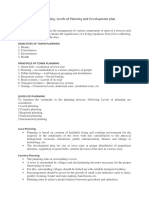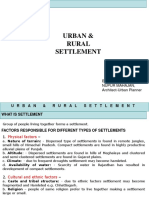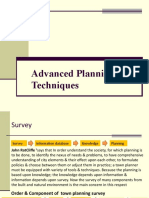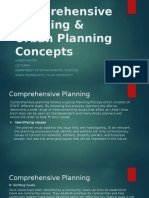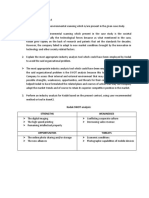Urban Planning
Urban Planning
Uploaded by
Lady Khen LosabiaCopyright:
Available Formats
Urban Planning
Urban Planning
Uploaded by
Lady Khen LosabiaOriginal Title
Copyright
Available Formats
Share this document
Did you find this document useful?
Is this content inappropriate?
Copyright:
Available Formats
Urban Planning
Urban Planning
Uploaded by
Lady Khen LosabiaCopyright:
Available Formats
7 Types of Urban Planning
1. Strategic Urban Planning
Strategic urban planning focuses on setting high-level goals and
determining desired areas of growth for a city or metropolitan area. The
result of the planning process is a strategic plan—also called the
development plan, core strategy, or comprehensive plan. The strategic
plan’s goals may include easing transportation throughout the city, creating
more community spaces, improving citizens’ quality of life, or encouraging
people to visit or move to the city.
2. Land-Use Planning
Land-use planning largely concerns legislation and policy, adopting
planning instruments like governmental statutes, regulations, rules, codes,
and policies to influence land use.
On a broad level, these planning instruments deal with the type, location,
and amount of land needed to carry out different functions of the city. They
also serve to zone or reserve land for certain purposes such as:
Residential, for buildings like apartment homes, single-family
residences, and condominiums
Commercial, for buildings like retail shops and office buildings
Industrial, for structures like manufacturing plants and warehouses
Municipal, for structures like police stations and courthouses
As with subsequent types of urban planning, consulting with the community
and relevant stakeholders is an important part of land-use planning to
ensure transparency, and incorporate a wide range of interests into the
overall plan. If you communicate your strategic plan well, then
transportation, commercial and industrial planning should flow right into
your plans.
3. Master Planning
Master planning is typically used for Greenfield development projects, or
building on undeveloped land—instead of modifying pre-existing structures
or spaces, you’re starting from scratch.
This type of urban planning envisions a future state for a given space, and
what it will take to achieve that vision. Urban planners must consider the
required zoning (from your land-use plan) and infrastructure (see concept 7
below) to make the project possible, such as residential and commercial
land, transportation considerations, road locations, etc. They must also
plan the location of urban amenities such as community facilities, schools,
parks, and the like.
4. Urban Revitalization
Urban revitalization focuses on improving areas that are in a state of
decline. The exact definition of a declining area will differ from city to city—
for example, areas that have a troubling number of failing businesses or a
stagnant or decreasing population growth. The improvement tactics city
leader’s use for revitalization will depend on the root cause of decline, and
may include things like repairing roads, developing infrastructure, cleaning
up pollution, and adding to parks and other public spaces, etc.
5. Economic Development
Economic development is about identifying areas of growth to foster
greater financial prosperity within the city, specifically by enticing
companies to build or move offices there. Subsequently, those companies
then hire local talent and drive commuter traffic to the new office. More
workers dining at local restaurants for lunch, getting gas at nearby gas
stations, and stopping by local grocery stores on the way home will boost
visibility and spend in the area.
6. Environmental Planning
Environmental planning is a type of strategic development that emphasizes
sustainability. Considerations for this type of urban planning include air
pollution, noise pollution, wetlands, and habitats of endangered species,
flood zone susceptibility, and coastal zone erosion, along with a host of
other environmental factors dealing with the relationship between natural
and human systems.
7. Infrastructure Planning
Infrastructure planning deals with the fundamental facilities and systems
that serve a city and its people, and how those facilities can support goals
laid out in the strategic plan. This type of urban planning covers:
Public works infrastructure such as water supply, sewage,
electricity, and telecommunications
Community infrastructure such as schools, hospitals, and parks
Safety and transportation such as roads, police, and fire facilities
As you can see from the above urban planning concepts, good planning
takes a lot of work. But when done correctly, planning at the city, county,
and state levels can have a positive, lasting impact on your community.
2. Urban planning theories
Planning theory is the body of scientific concepts, definitions, behavioral
relationships, and assumptions that define the body of knowledge of urban
planning. There are nine procedural theories of planning that remain the
principal theories of planning procedure today: the Rational-
Comprehensive approach, the Incremental approach, the Transformative
Incremental (TI) approach, the Tran active approach, the Communicative
approach, the Advocacy approach, the Equity approach, the Radical
approach, and the Humanist or Phenomenological approach.
3. Urban planning meaning
Urban planning, design and regulation of the uses of space that focus on
the physical form, economic functions, and social impacts of the
urban environment and on the location of different activities within it.
Because urban planning draws upon engineering, architectural, and social
and political concerns, it is variously a technical profession, an endeavor
involving political will and public participation, and an academic discipline.
Urban planning concerns itself with both the development of open land
(“green fields sites”) and the revitalization of existing parts of the city,
thereby involving goal setting, data collection and analysis, forecasting,
design, strategic thinking, and public consultation.
4. Urban planning examples
Early examples of efforts toward planned urban development include
orderly street systems that are rectilinear and sometimes radial; division of
a city into specialized functional quarters; development of commanding
central sites for palaces, temples, and civic buildings; and advanced
systems of fortification, water supply, and drainage. Most of the evidence is
in smaller cities that were built in comparatively short periods as colonies.
Often the central cities of ancient states grew to substantial size before
they achieved governments capable of imposing controls.
5. What is the important of urban and rural planning in sustainable?
In order to reduce migration to cities and reach sustainable social and
economic development, we first need to harmonize rural and urban
development by reducing disparities in living conditions—which includes
increasing accessibility to energy supply, reducing and suppressing
pollution, as well as CO2 and other greenhouse gas emissions. From an
environmental perspective, as they continue to grow, cities place growing
pressure on land, energy and resources, which can lead to greater
environmental threats. At the same time, their increased importance means
that environmentally sustainable solutions for urban areas have significant
potential for mitigating resource consumption. Then urban planning is a
composed a lot of people and infrastructures. As opposed to urban
planning, if there a lot of people and infrastructures, in rural areas it is
limited. That is why urban and rural planning is important to sustain
resources in city or country.
You might also like
- Singapore’s Business Park Real Estate: - Viability, Design & Planning of the Knowledge-Based Urban Development (Kbud)From EverandSingapore’s Business Park Real Estate: - Viability, Design & Planning of the Knowledge-Based Urban Development (Kbud)No ratings yet
- Housing Site Selection Criteria Report 2 1amdsNo ratings yetHousing Site Selection Criteria Report 2 1amds10 pages
- Training On Environmental Planning: January 26-30, 2016100% (1)Training On Environmental Planning: January 26-30, 201655 pages
- Historytheoriesprinciplesofurbanandregionalplanning 160512050926No ratings yetHistorytheoriesprinciplesofurbanandregionalplanning 160512050926214 pages
- Town Planning Levels - Forms & Development Plan PDFNo ratings yetTown Planning Levels - Forms & Development Plan PDF4 pages
- Regional Planning: Implementation of Regional Plans Semester-7No ratings yetRegional Planning: Implementation of Regional Plans Semester-724 pages
- Q & A 2017 On Urban & Land Use Planning - Enp - Jeffy Baluran - Ab - LLB - Reb - Rea0% (1)Q & A 2017 On Urban & Land Use Planning - Enp - Jeffy Baluran - Ab - LLB - Reb - Rea10 pages
- P201 - Unit 1 - Module 2 History of PlanningNo ratings yetP201 - Unit 1 - Module 2 History of Planning2 pages
- 7 Steps in A Community Planning and ProgressNo ratings yet7 Steps in A Community Planning and Progress29 pages
- Unit - III Urban Sociology, Economics, Geography100% (2)Unit - III Urban Sociology, Economics, Geography37 pages
- 4 Sustainable Planning Concepts at The Beginning of 21stNo ratings yet4 Sustainable Planning Concepts at The Beginning of 21st48 pages
- Basic Terms and Definitions in Urban PlanningNo ratings yetBasic Terms and Definitions in Urban Planning4 pages
- Concentric Zone Theory: Torio, Diane Rae G. ARC4203 Planning 3No ratings yetConcentric Zone Theory: Torio, Diane Rae G. ARC4203 Planning 33 pages
- UAP Planning Seminar 2010 Module 1 World PlanningNo ratings yetUAP Planning Seminar 2010 Module 1 World Planning88 pages
- Introduction To Housing: Archt. Marcelino Enalas Dumpa, Asst ProfNo ratings yetIntroduction To Housing: Archt. Marcelino Enalas Dumpa, Asst Prof20 pages
- Kevin Lynch: City Elements Create Images in Our Mind, 1960 by Ethan SundilsonNo ratings yetKevin Lynch: City Elements Create Images in Our Mind, 1960 by Ethan Sundilson4 pages
- Socio-Cultural Basis of Design CommunitiesNo ratings yetSocio-Cultural Basis of Design Communities5 pages
- Kodak SWOT Analysis: Strengths WeaknessesNo ratings yetKodak SWOT Analysis: Strengths Weaknesses1 page
- Value Curve-Skin Care and Beauty Products ShopNo ratings yetValue Curve-Skin Care and Beauty Products Shop1 page
- DR Swamy PLAB Courses LTD.: Plab 1 Mock Test: 25 October 2018 Time Allowed: 3HrsNo ratings yetDR Swamy PLAB Courses LTD.: Plab 1 Mock Test: 25 October 2018 Time Allowed: 3Hrs29 pages
- PDF Imagining Xerxes Ancient Perspectives On A Persian King 1. Publ Edition Emma Bridges Download100% (8)PDF Imagining Xerxes Ancient Perspectives On A Persian King 1. Publ Edition Emma Bridges Download44 pages
- MKT 304 Session 1-IMC - An IntroductionNo ratings yetMKT 304 Session 1-IMC - An Introduction35 pages
- TECHNICAL PROPOSAL LIGHTNING SYSTEM - Franklin RodNo ratings yetTECHNICAL PROPOSAL LIGHTNING SYSTEM - Franklin Rod5 pages
- Laporan Akhir M3 - Ridho Aulia Ahmad - 120150079 - GeotekNo ratings yetLaporan Akhir M3 - Ridho Aulia Ahmad - 120150079 - Geotek22 pages
- Failure of TRLY and TREG Card in MARK VI-OCT09pdf PDFNo ratings yetFailure of TRLY and TREG Card in MARK VI-OCT09pdf PDF5 pages
- Get Management Organisational Behaviour 11th Edition Laurie Mullins Free All Chapters100% (2)Get Management Organisational Behaviour 11th Edition Laurie Mullins Free All Chapters53 pages
- Photo Warehouse Film Development Chart Push Processing (B/W)No ratings yetPhoto Warehouse Film Development Chart Push Processing (B/W)1 page
- Singapore’s Business Park Real Estate: - Viability, Design & Planning of the Knowledge-Based Urban Development (Kbud)From EverandSingapore’s Business Park Real Estate: - Viability, Design & Planning of the Knowledge-Based Urban Development (Kbud)
- Training On Environmental Planning: January 26-30, 2016Training On Environmental Planning: January 26-30, 2016
- Historytheoriesprinciplesofurbanandregionalplanning 160512050926Historytheoriesprinciplesofurbanandregionalplanning 160512050926
- Town Planning Levels - Forms & Development Plan PDFTown Planning Levels - Forms & Development Plan PDF
- Regional Planning: Implementation of Regional Plans Semester-7Regional Planning: Implementation of Regional Plans Semester-7
- Q & A 2017 On Urban & Land Use Planning - Enp - Jeffy Baluran - Ab - LLB - Reb - ReaQ & A 2017 On Urban & Land Use Planning - Enp - Jeffy Baluran - Ab - LLB - Reb - Rea
- 4 Sustainable Planning Concepts at The Beginning of 21st4 Sustainable Planning Concepts at The Beginning of 21st
- Concentric Zone Theory: Torio, Diane Rae G. ARC4203 Planning 3Concentric Zone Theory: Torio, Diane Rae G. ARC4203 Planning 3
- Introduction To Housing: Archt. Marcelino Enalas Dumpa, Asst ProfIntroduction To Housing: Archt. Marcelino Enalas Dumpa, Asst Prof
- Kevin Lynch: City Elements Create Images in Our Mind, 1960 by Ethan SundilsonKevin Lynch: City Elements Create Images in Our Mind, 1960 by Ethan Sundilson
- DR Swamy PLAB Courses LTD.: Plab 1 Mock Test: 25 October 2018 Time Allowed: 3HrsDR Swamy PLAB Courses LTD.: Plab 1 Mock Test: 25 October 2018 Time Allowed: 3Hrs
- PDF Imagining Xerxes Ancient Perspectives On A Persian King 1. Publ Edition Emma Bridges DownloadPDF Imagining Xerxes Ancient Perspectives On A Persian King 1. Publ Edition Emma Bridges Download
- TECHNICAL PROPOSAL LIGHTNING SYSTEM - Franklin RodTECHNICAL PROPOSAL LIGHTNING SYSTEM - Franklin Rod
- Laporan Akhir M3 - Ridho Aulia Ahmad - 120150079 - GeotekLaporan Akhir M3 - Ridho Aulia Ahmad - 120150079 - Geotek
- Failure of TRLY and TREG Card in MARK VI-OCT09pdf PDFFailure of TRLY and TREG Card in MARK VI-OCT09pdf PDF
- Get Management Organisational Behaviour 11th Edition Laurie Mullins Free All ChaptersGet Management Organisational Behaviour 11th Edition Laurie Mullins Free All Chapters
- Photo Warehouse Film Development Chart Push Processing (B/W)Photo Warehouse Film Development Chart Push Processing (B/W)














